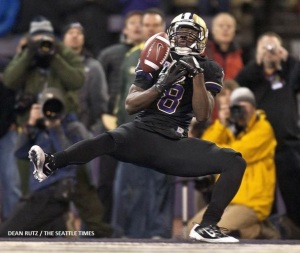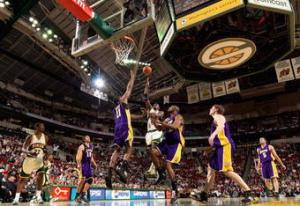
(Final of a three part series on the NBA’s arena and fiscal strategy, published October & November, 2010)
Last night in Portland, Oregon, broken-hearted Seattle Supersonic fans showed up in mass at the Rose Garden specifically to get themselves broadcast on national TV. However, what they saw may have caused more internal bleeding, as they witnessed their former franchise pull out a terrific overtime win that included a furious and breathtaking last-minute come-from-behind rally.
Green-and-gold-clad spectators held up signs directly behind the end line, hoping to visually remind the rest of the nation that fans in Seattle have neither forgiven nor forgotten what David Stern and Clay Bennett did to them. Forty years of history lost with a seriously damaged and bitter former fan base in both Vancouver BC and Seattle, if not Alaska and the entire NW corner of the United States and beyond.
The former Sonic squad, now known as the Oklahoma City Thunder, still sounds like a junior high AAA team to most fans in Seattle. The franchise has amassed a young exciting nucleus since fleeing Seattle, in spite of unimaginative uniforms that look like they were designed by an IRS tax accountant. The team is filled with lottery picked youngsters and a bright future.
After hearing David Stern’s rhetoric this past summer, perhaps Seattle’s barren professional basketball scene might soon be shared by another 32 cities? This past July, the hated commissioner claimed the NBA was losing “huge amounts of money” and put the number in the $350 to $400 million range for the 2009-10 season alone.
If that is anywhere close to truth, perhaps Seattle ought to be celebrating escaping this mess, rather than mourning their lost franchise?
Stern has an impossible, conflicting task this year. While trying to convince skeptical city council members across the nation to pony up hundreds of millions to replace arenas barely two decades-old, he’s also pleading poverty in an effort to lower the NBAplayers’ salary structure.
Sources confirm the poverty argument, listing that the teams losing money includeAtlanta, Memphis, Detroit, Miami, Orlando, New Orleans, Oklahoma City,Indiana, New Jersey, Minnesota, Charlotte, Milwaukee and Philadelphia—news that makes Seattle and Vancouver fans a bit gleeful.
Build new billion-dollar arenas using public taxpayer money for a league that is losing hundreds of millions? How does this make sense?
Most flabbergasting to NBA fans across the globe is that the same Oklahoma City Thunder allegedly lost $9.7 million last season in a relatively new arena, yet still signed young superstar Kevin Durant to a new five-year contract. Perhaps one of the reasons why Stern’s whining has been met with scoffing from the player’s union?
If David Stern and the owners are telling the truth, why did teams shell out nearly a billion dollars in free-agent player contract commitments this past off-season? Why build new billion dollar arenas if teams are still losing money after moving in? And how could the Thunder afford to sign Durant to a maximum contract, if they are indeed losing a ton of money under his rookie contract?
More importantly to fans of the now lost Supersonics franchise, what will become of Oklahoma City’s nucleus of talented young players once this new NBA agreement is put into place?
Contracts to Jeff Green, James Harden and Russell Westbrook are all coming due within the next several years, and it is likely that all three will demand significant raises over their rookie amounts.
Especially considering that the New York Knicks paid knucklehead Eddy Curry $10 million last season, which increases to $11.2 million this year as part of a five year $60 million deal he signed. The same Eddy Curry who averaged 1.7 in 2008-09 and 3.7 points per game in 2009-10, and has been a perennial nightmare for the Knicks off the court.
If deals are based on actual talent and personal character, and these young Thunder players use Curry’s contract as a yardstick for their own demands, chances are the Thunder won’t be an exciting young team for long. Oklahoma City will never be able to afford it.
The average salary in the NBA is nearly $5.5 million, and the minimum salary for the last rookie on the end of the bench is just under $475,000. Players get 57 percent of all revenue under the league’s current salary cap. David Stern would like to decrease that by one third.
Last summer, newspaper columnists and talk show hosts praised the Thunders’ Kevin Durant for signing this new “selfless” contract, demonstrating his personal character and wonderful concern for the Oklahoma City fanbase.
But there may be more to this story than Durant feeling love and affection for the small country village that he plays for. Durant’s agent, Aaron Goodwin, told ESPN.com’s J.A. Adande that, “The deal will be worth about $86 million over five years.” This is in comparison to Durant’s rookie contract which paid him a paltry $5 million per season.
A salary increase of three to four times his original, not including endorsement deals, may have been lost had he not done the deal last summer. David Stern is determined to eliminate or severely reduce these kinds of contracts.
Goodwin spun the situation by saying, “Kevin wanted to make this commitment to the Thunder because he and his family are very appreciative of the commitment that the Thunder have made to him.”
Yes, well of course he did.
More likely, his sudden devotion to Oklahoma has more to do with the NBA’s collective bargaining agreement set to expire in June of 2011.
Breaking down the Thunder’s situation using napkin math, if the current Forbes claims are correct, it would mean the Thunder would easily be in the red by as much as $40-50 million if they were to sign their three young stars in addition to what they are now obligated to pay Durant, let alone the half dozen of other future stars that pack their roster.
The Thunder situation is disturbing to both the league and Oklahoma City fans because this team allegedly plays in one of the better revenue-generating arenas. Or at least that was the justification given to owners voting to approve the move from Seattle to Oklahoma in the bitter 2008 fight.
Stern says he is determined to drop player costs by $750 to $800 million. Deputy NBAcommissioner Adam Silver added that the league spends about $2.1 billion annually in player salaries and benefits, and that owners are in a “dis-economic situation.”
Both Stern and Silver insist that no matter how well the league does at the box office, it won’t change the fact that an overhaul is necessary. Silver said “Even though we reported record season ticket sales over the summer and otherwise a very robust revenue generation, because of the built-in cost of the system, it’s virtually impossible for us to move the needle in terms of our losses.”
Perhaps the larger problem is the severe credibility issue that David Stern is wrestling with after his perceived hostility towards Seattle? Very few players believe the claims that their teams are actually losing money, and very few city council people believe the rhetoric Stern is spewing about advantages that NBA franchises offer communities.

Especially when NBA owners have demonstrated an uncanny ability to break arena leases whenever it suits them.
Last month as Stern was pleading poverty in spite of billions in new tax-payer funded arenas over the past decade, which were built specifically to cure the fledgling revenue streams of this poor deprived basketball league, fan comments in newspapers and on-line sites were not kind.
Instead, they were littered with scoffing statements like “franchises are just a front for other business ventures” and “David Stern is lying!”
Stern recently threatened to contract unprofitable franchises to help deal with this terrible financial crisis that all NBA teams are wrestling with, apparently, still failing to appreciate how deep his credibility problem runs.
Naysayers argue that NBA franchises are actually just a single part of a far larger conglomerate for these owners. If the conglomerate earns a profit while the franchise loses money, they reason, an owner can hardly claim that his team is losing money.
If, for example, an NBA “franchise” loses money while outside periphery businesses that surround it make millions, how can you claim a loss?
If Ticketmaster and team cable TV deals, clothing industries and parking lots earn huge profits while the franchise loses money, is it not merely a matter of “part of the sum?” How can an owner justifiably claim a loss if surrounding businesses earn profits?
Do you believe David Stern’s claims that the NBA is losing money?
YesNoSubmit Vote vote to see results
Shouldn’t the entire conglomerate of businesses be considered in these negotiations, rather than just the one single component that owners claim is losing money? Fans insist it’s a dishonest approach when owners structure their franchises to show a loss.
Others argue that team owners are so vastly wealthy that it doesn’t matter if they lose money because the franchise is merely a toy for them to coddle in their spare time. Like a sailboat, blow-up doll, or an expensive car that loses appreciation over time.
Stern’s arguments might scare the masses if anyone on the outside actually knew what the truth is. But the problem is that the general public has no idea what the truth is, even when owners “open the books” for players and fans alike.
Nobody seems in the mood to believe what David Stern is preaching, and for good reason, if the recent Seattle situation is any indication of what Stern considers ethical behavior.
Everybody assumes the books are cooked and that owners are playing accounting games while hiding the truth, to justify cutting player salaries. Otherwise, owners wouldn’t be stupid enough to sign players to maximum contracts. Would they?
Businesses that lose money usually cut costs! They certainly don’t add millions in player contracts and spend money like drunken sailors on shore leave.
Adding to the skepticism is the underhanded lease language the NBA is famous for.
For example, Thunder fans likely failed to appreciate that in Oklahoma City is an ignored and vague escape clause in their lease, stating (according to a report in ESPN NBA in March of 2008) that, “The agreement contains an exit clause that would allow the SuperSonics to leave any time after their sixth season in Oklahoma City if there is a significant drop in the team’s revenues.”
Furthermore, there is the general understanding that professional sports franchises are routinely sold for far more than they are purchased for. For example, Howard Shultz purchased the Sonics in 2001 for $200 million, but in 2006 sold the franchise for $350 million to Clay Bennett.
Nor does winning or losing seem to affect the price tag of franchises.
Ted Leonsis bought the Wizards from the Pollard family, a team that has only won two playoff series since 1980, for over $500 million this past summer (although that does include the arena).
Bruce Ratner purchased the New Jersey Nets in the fall of 2004 for $300 million, claiming he lost $20 to $30 million for four straight years. He then sold the franchise to Russian billionaire Mikhail Prokhorov four years later, with some reports claiming the total deal was for north of $700 million as part of the Barclay’s Center in Brooklyn.
Whatever the truth is, it’s becoming apparent that next year’s 2011-12 season is in dire trouble. This cannot bode well for cities like Orlando, who just opened their sparkling new $480 million arena with the city picking up most of the expense.
With potential lost seasons and a very shaky national economy, David Stern has a very difficult task convincing players to concede to pay cuts while at the same time, trying to convince cities that the NBA is so profitable that they would be foolish to not kick in public taxpayer funds for new arenas!
Read Phil’s latest article on this subject at: http://bleacherreport.com/articles/610697-time-for-a-competing-professional-basketball-league-in-north-america
Part 1 of this series published October 5, 2010 can be found at:http://bleacherreport.com/articles/483219-seattle-and-the-message-sent-by-the-nba-by-banning-key-arena
Part 2 of this series published October 30, 2010 can be found at:http://bleacherreport.com/articles/505644-orlando-magic-raise-bar-in-the-nbas-cold-war-for-new-arenas-and-revenue-streams
For more information, be sure to watch the superb documentary Sonicgage.org
Another note-worthy article deserving a read by Neal Collins, entitled “White Elephants and Wasted Millions” A Warning To The World Cup Hopefuls” at:http://bleacherreport.com/articles/515728-white-elephants-and-wasted-millions-a-warning-to-the-world-cup-hopefuls






 Otto Greule Jr/Getty Images
Otto Greule Jr/Getty Images Stephen Dunn/Getty Images
Stephen Dunn/Getty Images Otto Greule Jr/Getty Images
Otto Greule Jr/Getty Images Otto Greule Jr/Getty Images
Otto Greule Jr/Getty Images












































 Harry How/Getty Images
Harry How/Getty Images Harry How/Getty Images
Harry How/Getty Images





 Eric Francis/Getty Images
Eric Francis/Getty Images Eric Francis/Getty Images
Eric Francis/Getty Images Eric Francis/Getty Images
Eric Francis/Getty Images Ronald Martinez/Getty Images
Ronald Martinez/Getty Images
 Ronald Martinez/Getty Images
Ronald Martinez/Getty Images Jonathan Ferrey/Getty Images
Jonathan Ferrey/Getty Images Jonathan Ferrey/Getty Images
Jonathan Ferrey/Getty Images Kevin C. Cox/Getty Images
Kevin C. Cox/Getty Images New state-of-the-art locker rooms financed by Phil Knight
New state-of-the-art locker rooms financed by Phil Knight Autzen Stadium on the University of Oregon campus
Autzen Stadium on the University of Oregon campus
 New basketball arena that opened this past February
New basketball arena that opened this past February
 Seattle’s Traffic Planning Board of Directors
Seattle’s Traffic Planning Board of Directors Ronald Martinez/Getty Images
Ronald Martinez/Getty Images As the
As the 
 New Key Arena with, entire interior rebuilt and luxury suites added, opening for the 1995-96 season
New Key Arena with, entire interior rebuilt and luxury suites added, opening for the 1995-96 season Original Seattle arena prior to complete rebuild in 1995, including floor being lowered 35ft and luxury suites added
Original Seattle arena prior to complete rebuild in 1995, including floor being lowered 35ft and luxury suites added Desperate Seattle Fans attempt to save team in 2008
Desperate Seattle Fans attempt to save team in 2008
 Tom Pennington/Getty Images
Tom Pennington/Getty Images There was a time not so long ago, when a series between the Vancouver
There was a time not so long ago, when a series between the Vancouver
 Sold out Qwest Field in Seattle for Barcelona vs Sounder match in July of 2009
Sold out Qwest Field in Seattle for Barcelona vs Sounder match in July of 2009 Seattle Sonics vs Vancouver Grizzlies
Seattle Sonics vs Vancouver Grizzlies Former home of the NBA Vancouver Grizzlies
Former home of the NBA Vancouver Grizzlies 2010 WInter Olympics
2010 WInter Olympics


 This past weekend, snippets of Seattle Supersonic fans were on national TV, behind the
This past weekend, snippets of Seattle Supersonic fans were on national TV, behind the 

 Doug Pensinger/Getty Images
Doug Pensinger/Getty Images Doug Pensinger/Getty Images
Doug Pensinger/Getty Images As much as Sonic fans despised golf-challenged
As much as Sonic fans despised golf-challenged 



 Once upon a time, the middle of April had Seattle fans revved up and jostling with excitement, knowing the likes of Gary Payton and Shawn Kemp would soon be tomahawk-thrilling us again.
Once upon a time, the middle of April had Seattle fans revved up and jostling with excitement, knowing the likes of Gary Payton and Shawn Kemp would soon be tomahawk-thrilling us again.


 Jonathan Ferrey/Getty Images
Jonathan Ferrey/Getty Images Steve Dykes/Getty Images
Steve Dykes/Getty Images Steve Dykes/Getty Images
Steve Dykes/Getty Images Jonathan Ferrey/Getty Images
Jonathan Ferrey/Getty Images Representative Tina Orwall, a Democrat from Des Moines,
Representative Tina Orwall, a Democrat from Des Moines,

 Otto Greule Jr/Getty Images
Otto Greule Jr/Getty Images Christian Petersen/Getty Images
Christian Petersen/Getty Images PN’s Bill Simmon’s radio show that he “had regrets” about how both the Vancouver
PN’s Bill Simmon’s radio show that he “had regrets” about how both the Vancouver

 Otto Greule Jr/Getty Images
Otto Greule Jr/Getty Images


 Harry How/Getty Images
Harry How/Getty Images


 Harry How/Getty Images
Harry How/Getty Images Chris Trotman/Getty Images
Chris Trotman/Getty Images













 Ethan Miller/Getty Images
Ethan Miller/Getty Images



 Steve Dykes/Getty Images
Steve Dykes/Getty Images Steve Dykes/Getty Images
Steve Dykes/Getty Images Steve Dykes/Getty Images
Steve Dykes/Getty Images
 Harry How/Getty Images
Harry How/Getty Images Harry How/Getty Images
Harry How/Getty Images AP photo/Ted S. Warren
AP photo/Ted S. Warren AP Photo/Ted S. Warren
AP Photo/Ted S. Warren AP Photo/Ted S. Warren
AP Photo/Ted S. Warren AP Photo/Ted S. Warren
AP Photo/Ted S. Warren AP Photo/Ted S. Warren
AP Photo/Ted S. Warren AP Photo/Ted S. Warren
AP Photo/Ted S. Warren
 Steve Dykes/Getty Images
Steve Dykes/Getty Images Ezra Shaw/Getty Images
Ezra Shaw/Getty Images Steve Dykes/Getty Images
Steve Dykes/Getty Images Steve Dykes/Getty Images
Steve Dykes/Getty Images
 Otto Kitsinger III/Getty Images
Otto Kitsinger III/Getty Images
 Ezra Shaw/Getty Images
Ezra Shaw/Getty Images Ezra Shaw/Getty Images
Ezra Shaw/Getty Images Ezra Shaw/Getty Images
Ezra Shaw/Getty Images Steve Dykes/Getty Images
Steve Dykes/Getty Images


 Jonathan Ferrey/Getty Images
Jonathan Ferrey/Getty Images Jonathan Ferrey/Getty Images
Jonathan Ferrey/Getty Images Jonathan Ferrey/Getty Images
Jonathan Ferrey/Getty Images Steve Dykes/Getty Images
Steve Dykes/Getty Images Jonathan Ferrey/Getty Images
Jonathan Ferrey/Getty Images




